Free Online Productivity Tools
i2Speak
i2Symbol
i2OCR
iTex2Img
iWeb2Print
iWeb2Shot
i2Type
iPdf2Split
iPdf2Merge
i2Bopomofo
i2Arabic
i2Style
i2Image
i2PDF
iLatex2Rtf
Sci2ools
INTERSENSE
2006
ACM
2006
ACM
Programming wireless sensor networks with logical neighborhoods
— Wireless sensor network (WSN) architectures often feature a (single) base station in charge of coordinating the application functionality. Although this assumption simplified the path to adoption of WSN technology, researchers are now being attracted by more decentralized architectures with multiple sinks and heterogeneous nodes. These scenarios are brought to an extreme in Wireless Sensor and Actor Networks (WSANs), where sensing and acting nodes collaborate in a decentralized fashion to implement complex control loops. In these settings, new ing abstractions are required to manage complexity and heterogeneity without sacrificing efficiency. In this paper we propose and define a logical neighborgramming abstraction. A logical neighborhood includes nearby nodes that satisfy predicates over their static (e.g., type) or dynamic (e.g., sensed values) characteristics. The span of the neighborhood and the definition of its predicates are specified declaratively, along with require...
INTERSENSE 2006 | Logical Neighborhoods | Sensor Networks | Wireless Sensor | Wireless Sensor Network |
| Added | 13 Jun 2010 |
| Updated | 13 Jun 2010 |
| Type | Conference |
| Year | 2006 |
| Where | INTERSENSE |
| Authors | Luca Mottola, Gian Pietro Picco |
Comments (0)

